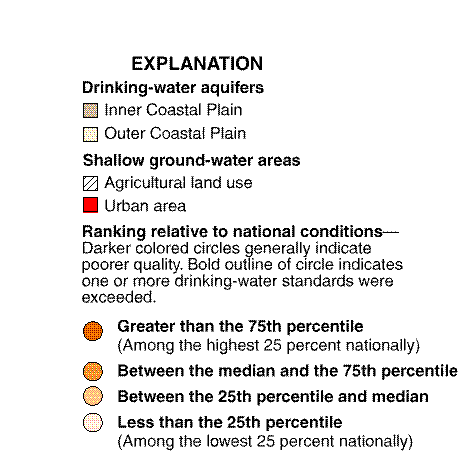Stream Quality || Ground-Water Quality
|
Seven major water-quality characteristics were evaluated for stream sites in each NAWQA Study Unit. Summary scores for each characteristic were computed for all sites that had adequate data. Scores for each site in the Albemarle-Pamlico Drainage Basin were compared to scores for all sites sampled in the 20 NAWQA Study Units during 1992-95. Results are summarized by percentiles; higher percentile values generally indicate poorer quality compared to that of other NAWQA sites. Water-quality conditions at each site also are compared to established criteria for protection of aquatic life. Applicable criteria are limited to nutrients and pesticides in water and semivolatile organic compounds, organochlorine pesticides, and PCBs in sediment. (Methods used to compute rankings and evaluate aquatic-life criteria are described by Gilliom and others, in press.) |
|
EXPLANATION Ranking of stream quality relative to all NAWQA stream sites -- Darker colored circles generally indicate poorer quality. Bold outline of circle indicates one or more aquatic-life criteria were exceeded.
|
Stream Quality || Ground-Water Quality
|
Five major water-quality characteristics were evaluated for ground-water studies in each NAWQA Study Unit. Ground-water resources were divided into two categories: (1) drinking-water aquifers, and (2) shallow ground water underlying agricultural or urban areas. Summary scores were computed for each characteristic for all aquifers and shallow ground-water areas that had adequate data. Scores for each aquifer and shallow ground-water area in the Albemarle-Pamlico Drainage Basin were compared to scores for all aquifers and shallow ground-water areas sampled in the 20 NAWQA Study Units during 1992-95. Results are summarized by percentiles; higher percentile values generally indicate poorer quality compared to that of other NAWQA ground-water studies. Water-quality conditions for each drinking-water aquifer also are compared to established drinking-water standards and criteria for protection of human health. (Methods used to compute rankings and evaluate standards and criteria are described by Gilliom and others, in press.) |

|
NITRATE | ||
|---|---|---|
|
Nitrate concentrations in ground water were low relative to national conditions. However, certain areas of the Albemarle-Pamlico Drainage Basin have higher concentrations than others. The highest concentrations are associated with well-drained soils of the inner Coastal Plain. About 5 percent of the wells in shallow aquifers of the inner Coastal Plain and 3 percent in the outer Coastal Plain exceeded the 10-mg/L drinking-water standard (U.S. Environmental Protection Agency, 1986). | ||
DISSOLVED SOLIDS | ||
|
Dissolved-solids concentrations in ground water were among the lowest relative to national conditions. The ground-water samples tested were from shallow, unconsolidated sedimentary units in the Coastal Plain, which contain relatively few easily dissolved minerals. |
||
VOLATILE ORGANIC COMPOUNDS | ||
|
|
Volatile organic compound detections in ground water were among the lowest in the Nation. Only four compounds were detected in ground water in three wells in the Coastal Plain, and these concentrations were below drinking-water standards. However, these compounds may be more common in urban areas not sampled in this study. | |
PESTICIDES | ||
|
Pesticide detections in the agricultural areas of the Coastal Plain were among the highest nationally. Three herbicides or their metabolites were detected at concentrations greater than 0.1 µg/L in shallow ground water. However, in general, pesticides applied to crops appeared in shallow ground water at concentrations less than drinking-water standards. | ||